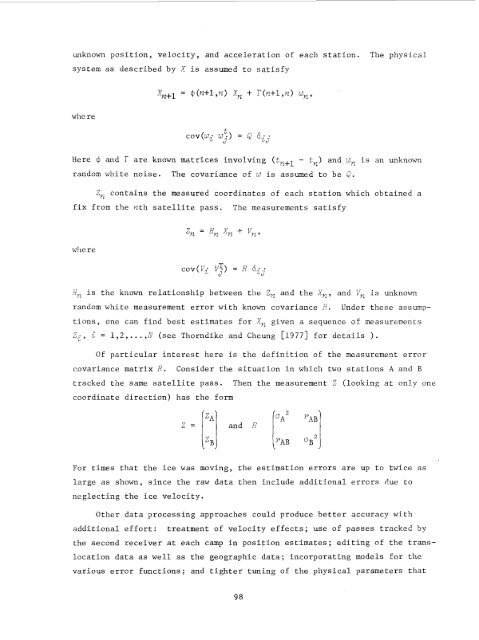AIDJEX Bulletin #40 - Polar Science Center - University of Washington
AIDJEX Bulletin #40 - Polar Science Center - University of Washington
AIDJEX Bulletin #40 - Polar Science Center - University of Washington
Create successful ePaper yourself
Turn your PDF publications into a flip-book with our unique Google optimized e-Paper software.
unknown position, velocity, and acceleration <strong>of</strong> each station.<br />
system as described by X is assumed to satisfy<br />
The physical<br />
.Yn+l = 4 (n+l ,n> xn + r (n+l ,n) w, ,<br />
where<br />
Here 4 and r are known matrices involving (t,+l - t,) and W, is an unknown<br />
random white noise. The covariance <strong>of</strong> w is assumed to be &.<br />
Z, contains the measured coordinates <strong>of</strong> each station which obtained a<br />
fix from the nth satellite pass. The measurements satisfy<br />
where<br />
Z, = Hn Xn -+ V,,<br />
‘in is the known relationship between the 2, and the Xn, and Vn is unknown<br />
random white measurement error with known covariance 8. Under these assump-<br />
tions, one can find best estimates €or X,<br />
given a sequence <strong>of</strong> measurerents<br />
52, i = 1,2, ..., €17 (see Thorndike and Cheung [1377] for details ).<br />
Of particular interest here is the definition <strong>of</strong> the measurement error<br />
covariance matrix R.<br />
Consider the situation in which two stations A and B<br />
tracked the same satellite pass. Then the measurement Z (looking at only one<br />
coordinate direction) has the form<br />
For times that the ice was moving, the estimation errors are up to twice as<br />
large as shown, since the raw data then include additional errors due to<br />
neglecting the ice velocity.<br />
Other data processing approaches could produce better accuracy with<br />
additional effort: treatment <strong>of</strong> velocity effects; use <strong>of</strong> passes tracked by<br />
the second receiver at each camp in position estimates; editing <strong>of</strong> the translocation<br />
data as well as the geographic data; incorporating models for the<br />
various error functions; and tighter tuning <strong>of</strong> the physical parameters that<br />
98








